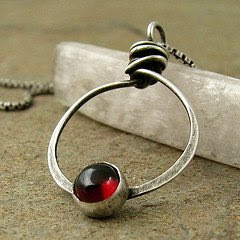Birthstone for the month of January: this article by Michele Cameron Drew looks at the science, history, mythology and traditional healing properties of the glorious garnet.
 | Mined in Switzerland, Tanzania, Australia, Brazil, Argentina, Myanmar(Burma), Arizona(US), South Africa, and Scotland, this glorious ancient symbol of friendship and January birthstone comes in many varieties. Six of these include spessartine, pyrope, grossular, andradite, almandine and uvarovite. Each of these varieties is a different mineral species. What makes this even more confusing is that many forms of garnet are combinations of the different minerals. |
| source |
Pyrope-almandine, more commonly known as rhodolyte is a mix of pyrope and almandine and is but one of these combinations. Other commonly used names are Hydrogrossular, Ant-hill, Leuco, Cape Ruby, Demantoid, Melanite, Thai, and Topazolite. Because of the highly concentrated amounts of calcium chromium, aluminum, and iron, and silicate, the garnet is believed to have great healing powers. When light hits this stone, it brings out its depth of color, making it look even more beautiful. Some garnets also exhibit "stars" and color variation. On the Mohs scale, garnet has a hardness of 7.0 - 7.5. It is not generally enhanced.
Although well known for a deep red variety, garnet is available in many colors, also commonly found in wine red and orangy brown tones. Demantoids(a clear green, flawless and expensive variety) are softer than other garnets. Difficult to find, green garnets of over five carats are rarer than emeralds of similar size and more brilliant than a diamond, but the brilliance is thwarted by the color, so a white diamond will appear more fiery to the naked eye. The larger the gem, as with most gemstones, the more flawed and poorly colored it will be. Depending on the variety, quality and size of the gem, one can pay anywhere from $40 to $5000 per carat. Due to its variations in color, garnet can often be mistaken for many more expensive gems.
History/Mythology
The word garnet comes from the Latin Garanatus meaning seedlike, and refers to the pomegranate. If you look at small pieces of garnet they do look like the pomegranate fruit covering the seeds. A hard and durable stone, the garnet has been found in graves dating as far back as 3000 BC. Small pieces of garnet were used in Ancient Greece as decoration to add a regal look.[Read more...]
2 comments:
hmmm... very interesting.
i wasn't aware that the garnet came in so many colors.
i lost the game.
Well, I'm glad that you enjoyed it, my young friend. THE GAME
Post a Comment